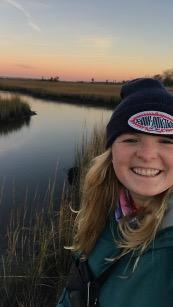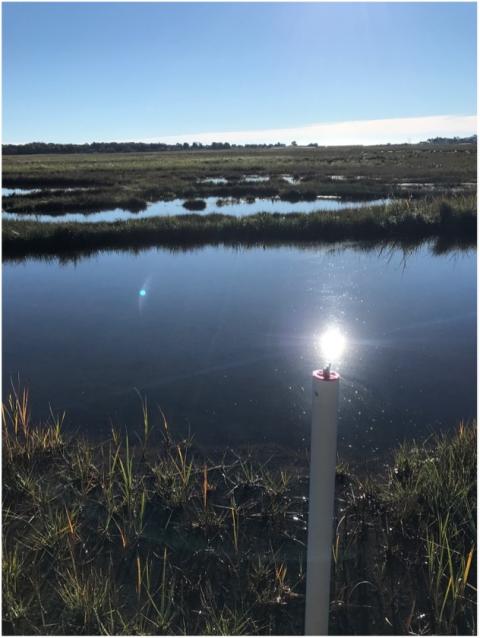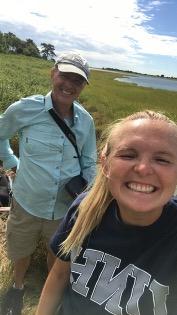Graduate Student Feature: Trudging through history to secure the future of New England’s salt marshes

Liz Gorrill in the field on Prudence Island, Rhode Island just before sunrise. PHOTO: LIZ GORRILL.
“You can be walking along, and it feels pretty solid – and all of a sudden you just drop down,” says Liz Gorrill, a UNH coastal ecology student and 2022-23 New Hampshire Sea Grant Graduate Fellow.
Strolling through a wetland and suddenly losing your footing is a familiar occupational hazard for Gorrill, who often encounters ditches along embankments built for historical agricultural use in her research studying the impact of sea-level rise on vegetation in New England’s salt marshes.
Although tidal gauges supply vital information about changes in water levels, Gorrill’s research is the first to measure the effect of sea level rise on marsh plant composition in embanked areas and has potential to drive more targeted wetland restoration.
Why are salt marshes important, and how are they changing?
Salt marshes are critical intertidal habitats that perform essential ecosystem services. In addition to purifying water by filtering pollutants and absorbing excess nutrients with the flooding of each tidal cycle, they protect our coastal communities from storm surge and serve as nurseries and safe havens for 75% of fish species. Marshes also sequester carbon at a rate faster than land ecosystems,1 providing an offset to climatic changes.
All along the East Coast, marshes are sinking due to the land surface being displaced during the last ice age some 20,000 years ago. Combined with higher global temperatures and acceleration of sea-level rise in recent decades, they are facing increased saturation and vegetation die-off, which can prevent sediment accretion that allows them to continue to grow.
This is especially true in embanked areas where tidal flooding can get trapped: “There are really, really large pools behind these embankments now,” says Gorrill. “In some cases, they’re going to start doing restoration work to help reestablish proper flooding to the marsh. But, if we can find these embankments before pools form, we can have hydrology restored and prevent vegetation from dying.”
Discovering the effects of farming days gone by

A monitoring well and pool near a visible embankment at Wells Reserve in Maine. PHOTO: LIZ GORRILL.
Agricultural embankments are hand-dug earthen structures built from the 1600s to late 1800s to alter hydrology and salinity across New England for farming of freshwater crops, such as root vegetables. Eroded by time and mostly forgotten over the years, they only started to garner attention about 10 years ago, when shallow pools suddenly became visible.
Today, Gorrill is using the opportunity to learn more about how hydroperiod in embanked areas influences the health of marsh vegetation to better direct restoration efforts.
Using familiar locations from a collaborative science project with the National Estuarine Research Reserve (NERR) and support from New Hampshire Sea Grant, she’s set up four research sites with historical agricultural use in New Hampshire, Maine, Rhode Island, and Connecticut.
“All we have is the anecdotal evidence about how altered hydrology is affecting marsh vegetation in these embankments,” she says. “Like with most things in science, if you don’t have hard evidence and can’t tell that story through data, you can’t get the permitting to do the restoration work. If we have the data, we can say, ‘If we act now, we can prevent this marsh from seeing the same fate as other marshes.’”
Backing up observations with hard data
Gorrill’s preliminary data findings through her field work last summer confirm embanked areas pose a bigger threat to salt marshes: in reference areas, she observed more abundant vegetation cover of low-marsh species and a huge difference in cover for fundamental high-marsh species such as Spartina patens, a tufted cordgrass resembling a cowlick that is critical to marsh sediment accretion.
“The high marsh is the part of the marsh we’re so concerned about right now,” says Gorrill. “That’s the part of the marsh we’re going to lose first. The low-marsh species can keep migrating back, but the high-marsh species don’t have any place to go. They have a small area of upland edge, but it’s so crucial to still have this habitat.”
With hydrology data from monitoring wells at the four New England marsh locations, Gorrill will pair the analysis with a vegetation metric she’s developing based on a ratio of low-to-high marsh species to prioritize marsh restoration efforts in New England, and beyond. By identifying issues such as vegetation die-off earlier, this metric could dramatically improve chances for marsh sediment accretion and regrowth.
Data accessibility that fuels change
As a scientist who grew up in Cape Cod with two public school teachers as parents — and a father who is a coastal ecologist — Gorrill feels fortunate to have been exposed to field work and scientific learning from a young age. Her research will undoubtedly facilitate other research, but she also aims to spark interest in the wider community, especially young people.
In collaboration with outreach staff at each of the four reserves, Gorrill is creating visuals to better explain the coastal ecology of the area for visitors. She is also developing lesson plans for students consisting of everything from data analysis for AP high school biology classes to next-generation science curriculum for elementary schoolers.
“I want the outcomes and products that I make from this project to be really accessible to people and easy to understand,” says Gorrill. “I think learning about these coastal ecosystems is so important and I want to try and make my research available to anybody who is interested in it.”

Gorrill in the field with her dad for a project at Waquoit Bay in Massachusetts. PHOTO: LIZ GORRILL.
Shifting from conservation to restoration
Besides making her research accessible, Gorrill’s primary focus is using her research to advocate for greater restoration support from state agencies. Given the status of New England’s marshes, she believes moving from a conservation to restoration mindset is necessary to successfully maintain these habitats for the future.
“We need to make that big push forward to actually start doing the restoration before it starts getting too far behind,” says Gorrill. “We’ve done the groundwork. People are doing this down South and in Rhode Island. It’s time to start up here where our marshes are being impacted even more because of our tidal regime.”
The restoration projects she’s been involved with so far (Save The Bay, Atlantic Coast Joint Venture) have documented significant success, with substantial vegetation regrowth in areas where small connecting water pathways called runnels are dug to allow for appropriate flooding that cycles with the tide.
Acting today to protect tomorrow
Research and restoration are gaining traction in New Hampshire – according to Gorrill, the state will soon begin to allow restoration using runnels to improve water migration and maintain marsh elevation.
This work will be instrumental over the next decade. By the mid-2030s, a new lunar cycle will make high tides even higher, bringing more sea water into marshes and making restoration more challenging. But Gorrill isn’t about to let this time slip:
“In the 27 years I’ve been alive, I’ve seen the salt marsh down the road from my childhood house change. I can remember those changes – I’ve seen so many shifts in the beaches,” she says. “If I’m seeing that in just the 27 years I’ve been alive, now that I’m finally in a place where I can do something about it, I’m going to.”
Reference
1. Marine Biological Laboratory. Salt marshes' capacity to sink carbon may be threatened by nitrogen pollution. ScienceDaily. Published August 26, 2019. Accessed May 7, 2023. https://www.sciencedaily.com/releases/2019/08/190826092340.htm